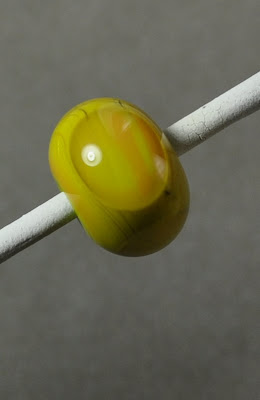
Well - this is one of the most interesting new glasses to come across my bench in a long time. This is Effetre Apple Blush, and if the name "Apple Blush" makes you think of just ripening apples, as they turn from green to red - well - bingo - cuz that's exactly what colour this glass is. Green - with blushes of a warm orangey colour.
You can see here - the ends of the rod show a warm hint of colour.
The warm colour blushes seem more pronounced in places that have received more re-heating. Not necessarily where they have cooled slowly, but where the have cooled and been reheated.
It is quite visible under these large clear dots - showing it is not a reduction effect. If it was - it would not be under the clear, or if I worked the entire bead in a reduction flame, it would have been out side the clear as prominently.
 Here is a self-coloured spacer - mostly a yellowy green ...
Here is a self-coloured spacer - mostly a yellowy green ... But, as I rotate it, on spot of colour blush on one side.
But, as I rotate it, on spot of colour blush on one side. This one is with ivory dots. No reaction to the ivory, but definitely more colour.
This one is with ivory dots. No reaction to the ivory, but definitely more colour.
As the glass heats - it goes a deeper version of the blush colour - so that the hot glass is a dark orange. It was unclear to me if it was going to retain that colour - which I could see developing on the rods - so I was nice to see that it stayed.
It is extremely easy to read the heat in this glass - I would recommend it for sculptural work.












